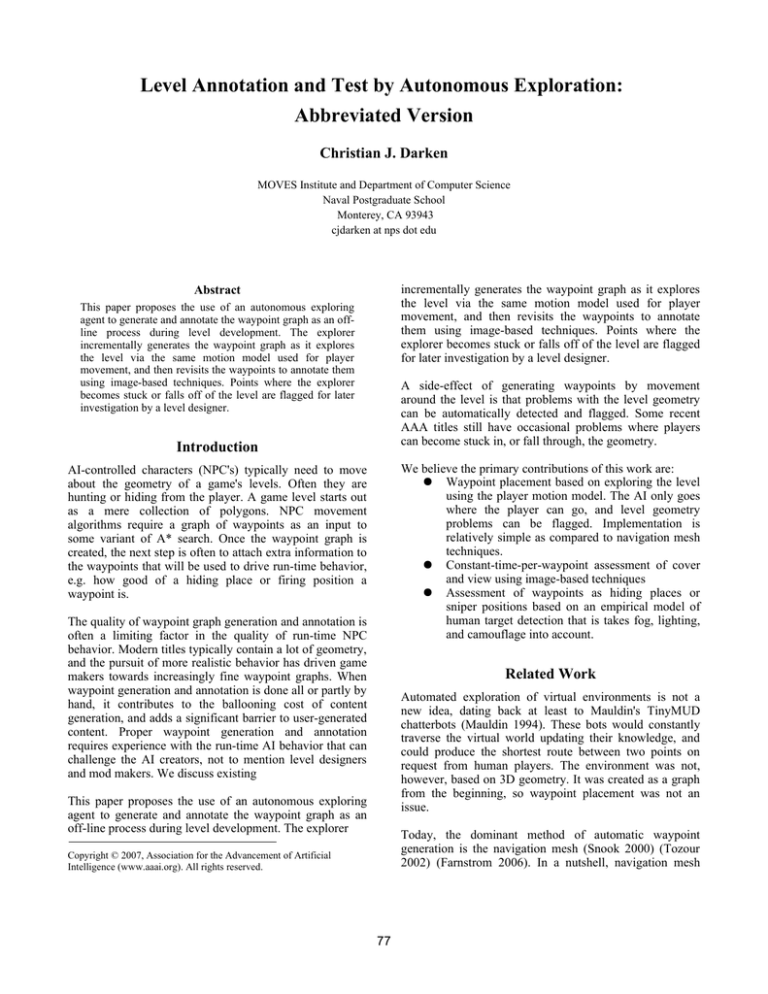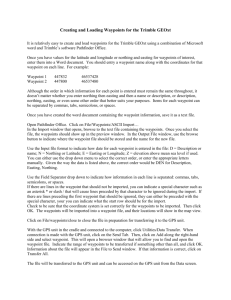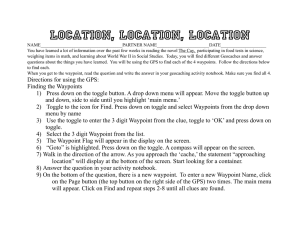
Level Annotation and Test by Autonomous Exploration:
Abbreviated Version
Christian J. Darken
MOVES Institute and Department of Computer Science
Naval Postgraduate School
Monterey, CA 93943
cjdarken at nps dot edu
incrementally generates the waypoint graph as it explores
the level via the same motion model used for player
movement, and then revisits the waypoints to annotate
them using image-based techniques. Points where the
explorer becomes stuck or falls off of the level are flagged
for later investigation by a level designer.
Abstract
This paper proposes the use of an autonomous exploring
agent to generate and annotate the waypoint graph as an offline process during level development. The explorer
incrementally generates the waypoint graph as it explores
the level via the same motion model used for player
movement, and then revisits the waypoints to annotate them
using image-based techniques. Points where the explorer
becomes stuck or falls off of the level are flagged for later
investigation by a level designer.
A side-effect of generating waypoints by movement
around the level is that problems with the level geometry
can be automatically detected and flagged. Some recent
AAA titles still have occasional problems where players
can become stuck in, or fall through, the geometry.
Introduction
We believe the primary contributions of this work are:
● Waypoint placement based on exploring the level
using the player motion model. The AI only goes
where the player can go, and level geometry
problems can be flagged. Implementation is
relatively simple as compared to navigation mesh
techniques.
● Constant-time-per-waypoint assessment of cover
and view using image-based techniques
● Assessment of waypoints as hiding places or
sniper positions based on an empirical model of
human target detection that is takes fog, lighting,
and camouflage into account.
AI-controlled characters (NPC's) typically need to move
about the geometry of a game's levels. Often they are
hunting or hiding from the player. A game level starts out
as a mere collection of polygons. NPC movement
algorithms require a graph of waypoints as an input to
some variant of A* search. Once the waypoint graph is
created, the next step is often to attach extra information to
the waypoints that will be used to drive run-time behavior,
e.g. how good of a hiding place or firing position a
waypoint is.
The quality of waypoint graph generation and annotation is
often a limiting factor in the quality of run-time NPC
behavior. Modern titles typically contain a lot of geometry,
and the pursuit of more realistic behavior has driven game
makers towards increasingly fine waypoint graphs. When
waypoint generation and annotation is done all or partly by
hand, it contributes to the ballooning cost of content
generation, and adds a significant barrier to user-generated
content. Proper waypoint generation and annotation
requires experience with the run-time AI behavior that can
challenge the AI creators, not to mention level designers
and mod makers. We discuss existing
Related Work
Automated exploration of virtual environments is not a
new idea, dating back at least to Mauldin's TinyMUD
chatterbots (Mauldin 1994). These bots would constantly
traverse the virtual world updating their knowledge, and
could produce the shortest route between two points on
request from human players. The environment was not,
however, based on 3D geometry. It was created as a graph
from the beginning, so waypoint placement was not an
issue.
This paper proposes the use of an autonomous exploring
agent to generate and annotate the waypoint graph as an
off-line process during level development. The explorer
Today, the dominant method of automatic waypoint
generation is the navigation mesh (Snook 2000) (Tozour
2002) (Farnstrom 2006). In a nutshell, navigation mesh
Copyright © 2007, Association for the Advancement of Artificial
Intelligence (www.aaai.org). All rights reserved.
77
techniques start from the raw polygons of the level and
produce a subset which constitute the navigation mesh.
Polygons are routinely split and sometimes merged in the
process of generating the mesh. Midpoints of edges of the
navigation mesh polygons are the waypoints. The beauty
of the navigation mesh is that the process of generating it
can be automated, at least to a large degree. The down-side
of the mesh is its difficulty of implementation. The mesh
generation algorithm must take into account the collision
geometry and motion model of the NPC's,. The
relationship between these data and the subset of the raw
geometry that belongs to the mesh is intricate, so much so
that we see this as a limitation of navigation meshes that
we would like to avoid.
explorer only runs off-line. Only the waypoint graph and
annotations are used at run-time.
Waypoint Finding
Given the geometry of a level and a single waypoint (or set
of waypoints) provided by the user, we describe a method
for covering the entire accessible portion of the level with
waypoints. Our technique assumes that an NPC motion
model has been defined (possibly the same one as is used
for player movement). We assume additionally that a finite
set of actions (terminating programs to drive the motion
model) is available. Each action represents a way to
explore that might result in accessing a new part of the
level. As a concrete example and the primary one we use in
practice, there might be six actions, each of which explores
a different point of the compass separated by 60 degrees.
The action set is a novel requirement of our technique, and
we discuss it further below. An example of a waypoint
graph is provided in Darken (2007b).
Automated annotation of waypoints for visibility and cover
was first described by Liden (2002). This work performed
ray traces (line-of-sight checks) off-line and cached the
results for use at run-time, e.g. for finding cover or firing
positions. Additional off-line analysis of the ray trace data
could be used to find and label sniping positions.
Straatman et al. (2006) describes an extension of Liden's
approach with a description of a compression strategy for
the ray-trace data and several examples of how this data
can be exploited on-line to produce various interesting
behaviors. Our work uses image-based methods rather than
ray-tracing to annotate waypoints. This approach has both
computational and performance advantages. From a
computation cost point of view, it replaces the O(N) per
waypoint cost of all-pairs ray tracing with O(1) approach
based on rendering a fixed number of views from each
waypoint. Note that the cover and visibility information we
cache is not intended to completely replace runtime chacks
as in Liden (2002). From a performance point of view,
rendered views provide an unprecedented opportunity to
evaluate hiding positions based on how likely a player
would be to detect an NPC located at a particular
waypoint. Darken and Paull (2006) describe some of the
problematic aspects of pre-computing cover information
and propose run-time augmentation of the waypoint graph
as a solution.
MAIN ALGORITHM
Add user waypoint(s) to list
For each waypoint on list
For each action:
Execute action until termination
Are we somewhere new?
If so, add new waypoint to list
Add new edge to waypoint graph
The “somewhere new” test requires some discussion. We
use a 3D Euclidean distance test against the waypoint set
for this purpose. We found the naïve O(N) approach of
testing against each existing waypoint to be unacceptably
slow. Efficient algorithms for “range queries” of this type
and their supporting data structures have been well studied
in the field of computational geometry, and there are many
good approaches. We implemented a kd-tree (Bentley and
Friedman 1979) for this purpose, reducing the computation
required on average (for points “in general position”) to
O(log N), though the worst case (all waypoints in a circle
around the query point) still requires O(N).
The automated processing of images from a virtual
environment, i.e. “synthetic vision” (Renault et al. 1990),
was applied to run-time navigation in a computer game by
Blumberg (1997). To our knowledge, this is its first
application to automated level annotation.
Implementing a set of actions need not be a difficult task.
The actions produce inputs to the motion model, and
respond to whatever outputs are available from the game
engine, so a general prescription for them cannot be given.
A guarantee of termination is required, and is easily
provided by implementing a time out for each action.
System Architecture
The autonomous level explorer has a similar architecture to
an artificial creature such as the famous fish of Tu and
Terzolpoulos (1994). It takes an image of the world as
input and interacts with world via (simplified) physics. Of
course, our motivation is not to create artificial life, but to
perform a task, and therefore knowledge of the true
positions of dummy targets placed in the world and even
control of the target color is allowable. Note that the
Our motion model requires a requested velocity as input.
The resulting motion must be checked by determining the
change in position of the motion model and its status
(walking, sliding, or falling). All six of our actions are
based on a single primitive action: moving in a straight line
78
to a specified x-y position. Our motion model allows
sliding along obstacles that do not squarely block the
requested step. After each requested step, the actual
progress achieved is checked. If the motion model is not
closer to the goal by at least half the expected distance
given the requested velocity and inter-frame time, the
action aborts. If the goal is reached, but the model is out of
control (sliding or falling), the action aborts. Otherwise,
the requested x-y position is achieved.
Darken, C. 2007a. “Computer Graphics-Based Target
Detection for Synthetic Soldiers”, Proceedings of Behavior
Representation in Modeling and Simulation (BRIMS)
2007.
Darken, C. 2007b. “Level Annotation and Test by
Autonomous Exploration”, The full version of this paper is
available at http://www.nps.navy.mil/cs/cjdarken/
Farnstrom, F. 2006. “Improving on Near-Optimality: More
Techniques for Building Navigation Meshes”, AI Game
Programming Wisdom 3, Charles River Media, pp.113128.
Level Test
A little more processing on top of the waypoint finding
algorithm discussed above provides a method of finding
two common types of problems with newly-created levels:
sticking points and holes. A sticking point is a place that is
accessible to the player, but which are impossible to leave.
The result of visiting a sticking point is usually that the
player is forced to restart the game, a very annoying
experience. A hole in a level is a place where the player
can fall through the geometry of the level. Once again, the
only remedy is usually a restart. Both types of problem are
encountered, even in some recent AAA titles.
Jones, B. (2006) A Computer Graphics Based Target
Detection Model. Master's Thesis, Naval Postgraduate
School.
Liden, L. 2002. “Strategic and Tactical Reasoning with
Waypoints”, AI Game Programming Wisdom, Charles
River Media, pp. 211-220.
Reece, D. and Wirthlin, R. (1996). Detection Models for
Computer Generated Individual Combatants. In
Proceedings of the 6th Conference on Computer Generated
Forces and Behavioral Representation.
Our algorithm for level testing is very simple. In the course
of exploring a level, if all actions available to the explorer
at a given waypoint fail to move it to a new location, that
waypoint is considered a sticking point. If any action
causes the agent to fall further than a specified maximum
distance, that waypoint is considered to be near a hole.
Waypoints that are sticking points or near holes are colored
red in the GUI, enabling them to be quickly detected by a
level creator and corrected. An example visualization is
given in Darken (2007b).
Renault, O., and N. Magnenat-Thalmann, D. Thalmann.
1990. “A vision-based approach to behavioral animation”,
The Journal of Visualization and Computer Animation
1(1).
Snook, G. 2000. “Simplified 3D Movement and
Pathfinding
Using
Navigation
Meshes”,
Game
Programming Gems, Charles River Media, pp. 288-304.
Waypoint Annotation
Straatman, R., Beij, A., and Van der Sterren, W. 2006
“Dynamic Tactical Position Evaluation”, AI Game
Programming Wisdom 3, Charles River Media, pp. 389404.
We annotate each waypoint with numbers to indicate how
much can be seen and how much protection from fire they
provide in each of the six directions. Additionally, we
analyze how visible the NPC model used at runtime would
be at this location using image-based techniques. These
techniques are described in Darken (2007b).
Tozour, P. 2002. “Building a Near-Optimal Navigation
Mesh”, AI Game Programming Wisdom, Charles River
Media, pp. 171-185.
References
Tu, Xiaoyuan and D. Terzopoulos. 1994. “Artificial
Fishes: Physics, Locomotion, Perception, Behavior”,
Proceedings of SIGGRAPH 94.
Bentley, J. and Friedman, J. 1979 “Data Structures for
Range Searching”, ACM Computing Surveys, Vol. 11,
Issue 4, pp. 397-409.
Blumberg, B. 1997. “Go with the Flow: Synthetic Vision
for Autonomous Animated Creatures”, Proceedings of
AAAI 1997.
Darken, C. and Paull, G. 2006. “Finding Cover in Dynamic
Environments”, AI Game Programming Wisdom 3, Charles
River Media, pp. 405-416.
79




